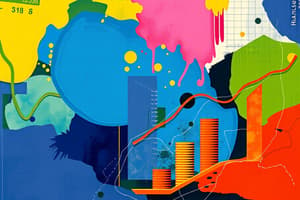Podcast
Questions and Answers
Which of the following are classified as indirect labour costs?
Which of the following are classified as indirect labour costs?
- Royalties for a product
- Rent expenses
- Hire charges for equipment
- Wages to maintenance workers (correct)
Which classification of costs includes expenses that remain constant regardless of activity levels?
Which classification of costs includes expenses that remain constant regardless of activity levels?
- Direct Expenses
- Semi-variable Costs
- Variable Costs
- Fixed Costs (correct)
What type of costs are incurred during a production process and measured for performance assessment?
What type of costs are incurred during a production process and measured for performance assessment?
- Standard Costs (correct)
- Future Costs
- Historical Costs
- Variable Costs
What is meant by semi-variable costs?
What is meant by semi-variable costs?
What distinguishes historical costs from future costs?
What distinguishes historical costs from future costs?
Which of the following is NOT an example of indirect expenses?
Which of the following is NOT an example of indirect expenses?
Which classification of costs is evaluated against actual performance to ensure cost control?
Which classification of costs is evaluated against actual performance to ensure cost control?
What type of cost varies directly with the level of output produced?
What type of cost varies directly with the level of output produced?
What kind of cost might include expenses for telephone use and normal maintenance?
What kind of cost might include expenses for telephone use and normal maintenance?
Which cost classification pertains to expenses like power, heating, and lighting?
Which cost classification pertains to expenses like power, heating, and lighting?
Flashcards are hidden until you start studying
Study Notes
Introduction to Cost and Management Accounting
- Cost and Management Accounting (CMA) aids in planning, decision-making, and controlling operations.
- Involves cost data (Cost Accounting) and includes revenue data (Management Accounting).
- Relies on concepts from both branches of accounting.
Features of CMA
- Utilizes information from Financial Accounting as a foundational basis.
- Combines qualitative and quantitative data for comprehensive analysis.
- Emphasizes future planning while relying on historical information.
- Incorporates flexible tools and techniques such as budgetary control and standard costing.
- Generated information focuses on facilitating decision-making.
Significance of CMA
- Systematic planning of enterprise activities enhances business performance.
- Supports budgeting and forecasting efforts.
- Facilitates efficient business operation control while managing production costs.
- Aims at waste reduction and improved employee productivity.
- Promotes effective communication among stakeholders.
Limitations of CMA
- Dependent on the accuracy of historical records.
- High installation and setup costs associated with implementing CMA systems.
Comparison Between Financial Accounting (FA) and Management Accounting (MA)
- Necessity: FA is mandatory while CMA is optional.
- Purpose: FA reports financial performance to outsiders; CMA supports internal decision-making.
- Users: FA targets external stakeholders; CMA is for internal management.
- Principles: FA must adhere to GAAP; CMA can utilize varying principles for useful reporting.
- Time Orientation: FA presents historical information; CMA includes both past data and future estimates.
- Information Content: FA captures limited characteristics; CMA captures financial and non-financial data.
- Precision: FA requires higher precision in information reporting.
- Reporting Frequency: FA reports are typically annual, while CMA generates frequent updates.
- Timeliness: CMA reports are shared sooner than FA reports.
- Report Scope: FA covers the organization collectively; CMA allows for departmental and product-specific reporting.
- Liability: FA holds the organization liable for public misrepresentation; CMA accountability lies with management.
Introduction to Cost
- Defined as the expenditure related to a specific activity or item.
- Represents the monetary measure of resources used in producing goods/services.
- Cost Object: Any entity needing separate cost measurement (e.g., products, orders).
Frequently Used Cost Types
- Historical Cost: Incurred at the time of acquisition.
- Estimated Cost: Pre-determined expectation of cost.
- Standard Cost: Scientific predetermined cost used for cost control.
- Total Cost: All costs associated with a given volume.
- Average Cost: Total cost divided by the volume considered.
- Marginal Cost: Change in cost with one unit output change.
- Differential Cost: Cost change at specific activity levels between alternatives.
- Sunk Cost: Historical costs that cannot be recovered.
- Relevant Cost: Future costs that differ based on alternatives.
Classification of Costs
- Costs can be grouped based on:
- Elements/Nature: Materials, labor, expenses.
- Functions/Activities: Production, marketing, administrative costs.
- Behavior: Fixed costs (constant), variable costs (proportional to output), semi-variable costs (partly fixed and variable).
- Time: Historical costs (previously incurred), future costs (estimated).
- Expiry: Expired vs. unexpired costs.
Detailed Cost Classifications
-
Element-based:
- Material Cost: Raw materials used in production.
- Labor Cost: Wages, bonuses, and compensations to employees.
- Indirect Costs: General costs not directly attributable to any specific product or service.
-
Function-based:
- Covers costs incurred in production, marketing, administration, and research & development.
-
Behavior-based:
- Fixed Costs: Stable across production levels (e.g., rent).
- Variable Costs: Change with output levels (e.g., direct materials).
- Semi-variable Costs: Combine fixed and variable characteristics (e.g., utility bills).
Time-based Cost Classification
- Historical Costs: Past incurred costs with verifiable evidence.
- Future Costs: Expected costs to be incurred, assessed via estimates and standards for variance analysis.
Studying That Suits You
Use AI to generate personalized quizzes and flashcards to suit your learning preferences.



